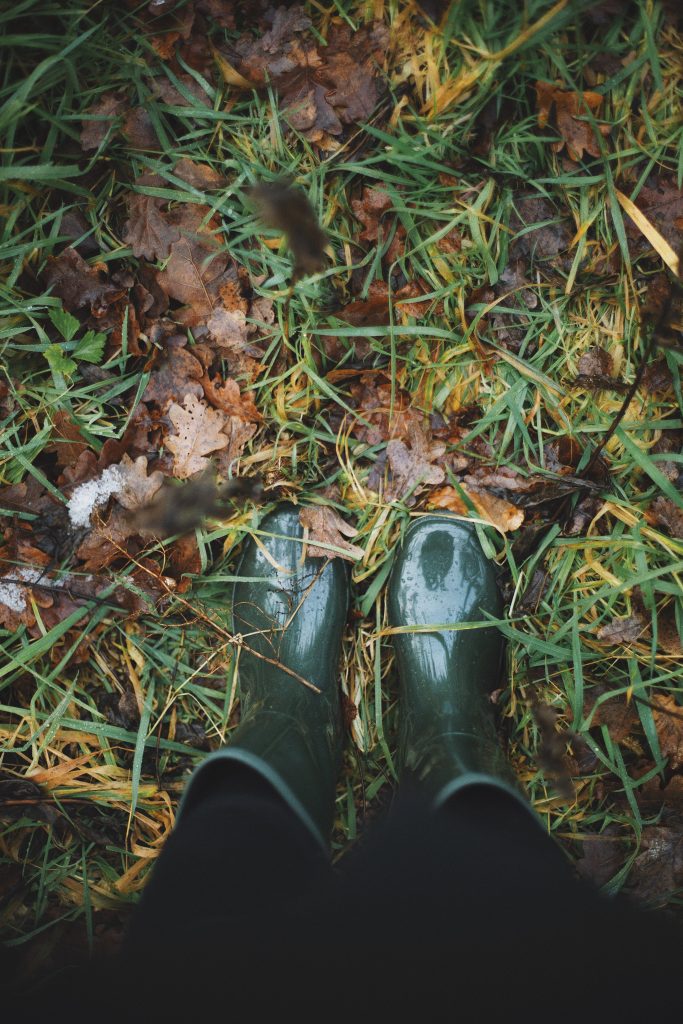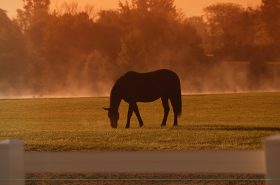I had a lot of “learn as I went” moments at my first barn job, including what items I actually needed for working at the barn. I learned that sneakers aren’t great foot protection, they don’t hold up well in certain elements, and they aren’t waterproof. Also even though a rain suit may look kind of ridiculous, it’s much more enjoyable to be warm, and dry, on a 30-minute drive home than it is being cold, and wet. Plus I’m going to share with you a couple of other items that are really helpful to have when you’re working at the barn.
Rain Gear
This item is absolutely essential to have on hand! Barn chores don’t disappear with bad weather, even in the pouring rain we still have to take the tractor out to spread the manure, run hay out to the run-in sheds, and check the water troughs. After a couple of times driving home completely soaked, I decided to quit the tough girl act, and buy a two-piece rain suit. Honestly, I think it is one of the items I am most proud of purchasing, no more driving home cold, and wet!
My rain gear also came in quite handy when I knew that I would have to give multiple horses baths. I don’t know how you talented people do it, staying dry while bathing the horses, the dogs, washing the cars, or watering flowers. Somehow I can get soaked doing pretty much all of the above. But, thankfully, not with my rain gear on!
Gloves
The next items you’ll want to have on hand working at the barn are multiple pairs of gloves and a couple of different kinds of gloves at that. The first being a heavy-duty work glove. It’s best that they fit well, and are flexible. While working at the barn you are going to be moving heavy bales of hay quite often. Moving one or two with your bare hands isn’t bad, but if you are stacking a load of hay you’ll probably wish you had a good pair of gloves. I’m all for being tough, getting callouses, and not letting a little pain slow me down, however if I’m being honest there is some work I’d still rather do with a good pair of gloves.
The second kind you’ll need is a box of good-quality disposable gloves. I personally prefer the nitrile gloves, because I think they tend to be a little thicker, and more durable than the other materials available. These gloves are useful for so many things in a barn: i.e. cleaning, wound care, hoof packing, etc. Plus they are great insulators under another pair of gloves in the winter! As I said with the rain gear if there is water around I will get wet, and that doesn’t change by the season. My hands, and ultimately my gloves would get soaked in the winter from rinsing water buckets, breaking up the ice in the water troughs, and anything else that had to do with water. With the disposable gloves underneath my work gloves, my hands stayed dry, and warm even when my work gloves got wet.
Boots
I love all my boots! Especially this pair of rubber muck boots, or rain boots, that I bought from Tractor Supply Co. over 8 years ago. I swear these things will last 100 years! I always emphasize getting a solid pair of muck boots, because you will use them a lot! Now even though my first pair is awesome, they are a little snug, which makes them pretty uncomfortable to layer socks in when winter comes around. This isn’t a huge problem one: because I live in the South, and two: there isn’t that much extra water use during the winter anyway. However, I did buy a second pair of cheaper rain boots that were a little bigger for those multiple-socks-wet kinds of winter days anyway. You can never be too prepared!
The second pair of boots you are going to need is either a steel toe, or reinforced toe, non-slip work boot. The first pair of boots I bought were a solid pair of reinforced-toe boots that really protected my foot from being broken once when the largest mare on the farm stood completely on my foot for a moment, or two. I definitely learned to be aware of my feet, and the horse’s feet that day! Plus if you are working on a farm that uses any type of machinery like tractors, mowers, or trailers it’s just a good idea to have your feet protected. I know I never wanted to miss out on riding time because of a broken foot! I also add in the non-slip part, because one rainy day I came a little too close to flying through the air after walking across a wet piece of wood. It’s good to be mindful of what type of material you may be walking over, and what a boot has for tread before you encounter any smooth wet surfaces at the barn.
First Aid Kit
Not only do I have a problem with staying dry, I’m the type of person who can get injured without knowing it. This is usually followed by playing the guessing game of how did I get blood on my shirt, and proceeding to check all the animals before realizing I’m the one bleeding! Because of that having a first aid kit on hand is a must for me, that way I can quickly get myself fixed up, and get right back to work.
I hope this list has been helpful for any of you who may be new to working at the barn. For those of you with a few more years under your belt, leave us a comment with some things that you have found helpful for working at the barn.
Love this blog? We think you will like My Daily Barn Routine




